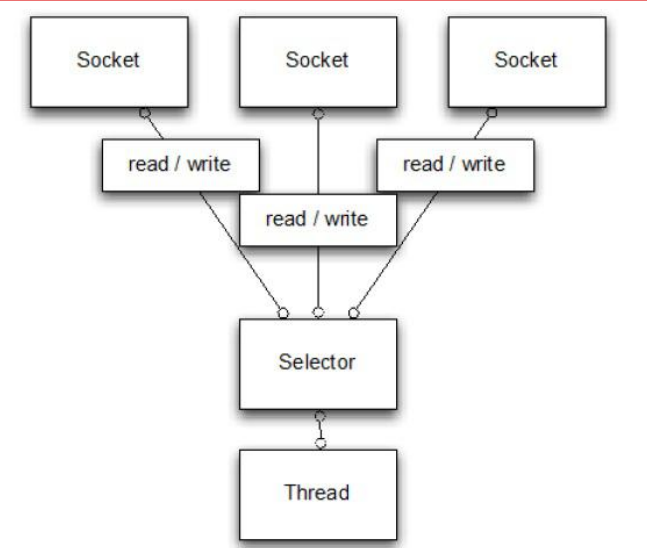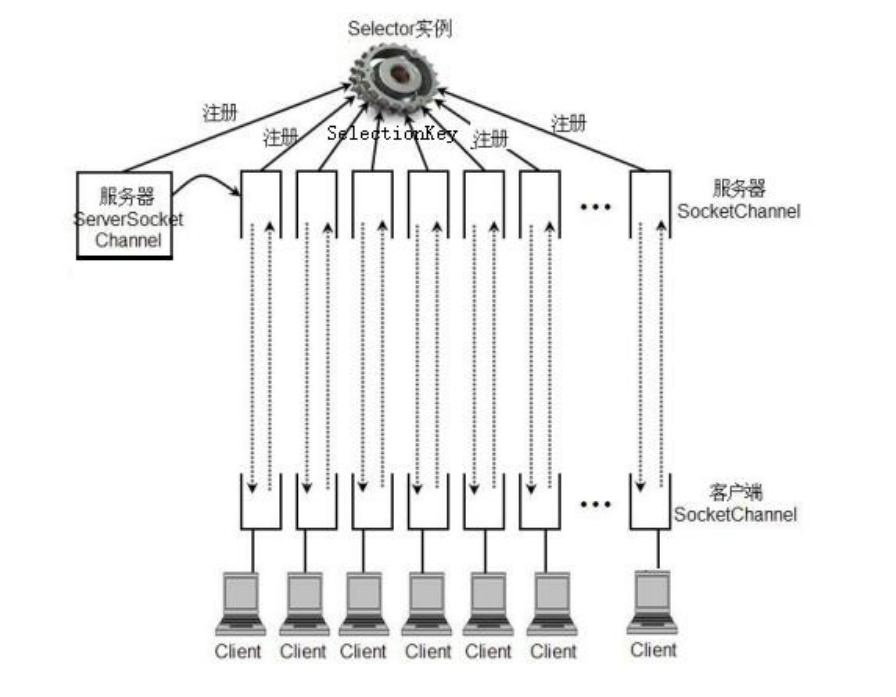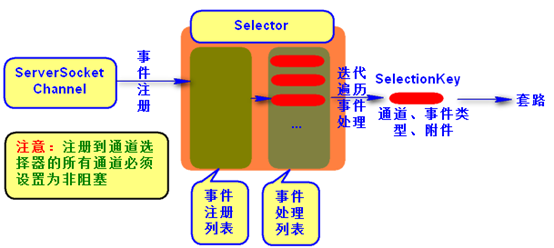(二)NIO之网络IO
概述和核心 API前面在进行文件 IO 时用到的 FileChannel 并不支持非阻塞操作,学习 NIO 主要就是进行网络 IO,Java NIO 中的网络通道是非阻塞 IO 的实现,基于事件驱动,非常适用于服务器需要维持大量连接,但是数据交换量不大的情况,例如一些即时通信的服务等等在 Java 中编写 Socket 服务器,通常有以下几种模式:一个客户端连接用一个线程,优点:程序编写简...
·
概述和核心 API
前面在进行文件 IO 时用到的 FileChannel 并不支持非阻塞操作,学习 NIO 主要就是进行网络 IO,Java NIO 中的网络通道是非阻塞 IO 的实现,基于事件驱动,非常适用于服务器需要维持大量连接,但是数据交换量不大的情况,例如一些即时通信的服务等等
在 Java 中编写 Socket 服务器,通常有以下几种模式:
- 一个客户端连接用一个线程,优点:程序编写简单;缺点:如果连接非常多,分配的线程也会非常多,服务器可能会因为资源耗尽而崩溃。
- 把每一个客户端连接交给一个拥有固定数量线程的连接池,优点:程序编写相对简单,可以处理大量的连接。缺点:线程的开销非常大,连接如果非常多,排队现象会比较严重。
- 使用 Java 的 NIO,用非阻塞的 IO 方式处理。这种模式可以用一个线程,处理大量的客
户端连接。
- Selector(选择器),能够检测多个注册的通道上是否有事件发生,如果有事件发生,便获取事件然后针对每个事件进行相应的处理。这样就可以只用一个单线程去管理多个通道,也就是管理多个连接。这样使得只有在连接真正有读写事件发生时,才会调用函数来进行读写,就大大地减少了系统开销,并且不必为每个连接都创建一个线程,不用去维护多个线程,并且避免了多线程之间的上下文切换导致的开销。

该类的常用方法如下所示:
- public static Selector open(),得到一个选择器对象
- public int select(long timeout),监控所有注册的通道,当其中有 IO 操作可以进行时,将
对应的 SelectionKey 加入到内部集合中并返回,参数用来设置超时时间 - public Set selectedKeys(),从内部集合中得到所有的 SelectionKey
- SelectionKey,代表了 Selector 和网络通道的注册关系,一共四种:
- int OP_ACCEPT:有新的网络连接可以 accept,值为 16
- int OP_CONNECT:代表连接已经建立,值为 8
- int OP_READ 和 int OP_WRITE:代表了读、写操作,值为 1 和 4
该类的常用方法如下所示: - public abstract Selector selector(),得到与之关联的 Selector 对象
- public abstract SelectableChannel channel(),得到与之关联的通道
- public final Object attachment(),得到与之关联的共享数据
- public abstract SelectionKey interestOps(int ops),设置或改变监听事件
- public final boolean isAcceptable(),是否可以 accept
- public final boolean isReadable(),是否可以读
- public final boolean isWritable(),是否可以写
- ServerSocketChannel,用来在服务器端监听新的客户端 Socket 连接,常用方法如下所示:
- public static ServerSocketChannel open(),得到一个 ServerSocketChannel 通道
- public final ServerSocketChannel bind(SocketAddress local),设置服务器端端口号
public final SelectableChannel configureBlocking(boolean block),设置阻塞或非阻塞模式,取值 false 表示采用非阻塞模式 - public SocketChannel accept(),接受一个连接,返回代表这个连接的通道对象
- public final SelectionKey register(Selector sel, int ops),注册一个选择器并设置监听事件
- SocketChannel,网络 IO 通道,具体负责进行读写操作。NIO 总是把缓冲区的数据写入通
道,或者把通道里的数据读到缓冲区。常用方法如下所示:
- public static SocketChannel open(),得到一个 SocketChannel 通道
- public final SelectableChannel configureBlocking(boolean block),设置阻塞或非阻塞模式,取值 false 表示采用非阻塞模式
- public boolean connect(SocketAddress remote),连接服务器
- public boolean finishConnect(),如果上面的方法连接失败,接下来就要通过该方法完成
连接操作 - public int write(ByteBuffer src),往通道里写数据
- public int read(ByteBuffer dst),从通道里读数据
- public final SelectionKey register(Selector sel, int ops, Object att),注册一个选择器并设置
监听事件,最后一个参数可以设置共享数据 - public final void close(),关闭通道

实战演示
使用 NIO 开发一个入门案例,实现服务器端和客户端之间的数据通信(非阻塞):

客户端:
package com.bestqiang.nio.socket;
import java.net.InetSocketAddress;
import java.nio.ByteBuffer;
import java.nio.channels.SocketChannel;
/**
* 网络客户端程序
* @author BestQiang
*/
public class NIOClient {
public static void main(String[] args) throws Exception {
// 文件操作是通过流得到通道,而网络IO操作是通过SocketChannel.open();
// 1. 得到一个网络通道
SocketChannel channel = SocketChannel.open();
// 2. 得到一个阻塞方式
channel.configureBlocking(false);
// 3.提供服务器端的IP地址和端口号
InetSocketAddress address = new InetSocketAddress("127.0.0.1",9999);
// 4.连接服务器端
if (!channel.connect(address)) {
while (!channel.finishConnect()) { //nio作为非阻塞式的优势
System.out.println("Client:连接服务器端的同时,我还可以干别的一些事情");
}
}
// 5.得到一个缓冲区,并存入数据
String msg = "Hello,Server!";
ByteBuffer buffer = ByteBuffer.wrap(msg.getBytes());
// 6.发送数据
channel.write(buffer);
System.in.read();
}
}
服务端:
package com.bestqiang.nio.socket;
import java.io.IOException;
import java.net.InetSocketAddress;
import java.nio.ByteBuffer;
import java.nio.channels.SelectionKey;
import java.nio.channels.Selector;
import java.nio.channels.ServerSocketChannel;
import java.nio.channels.SocketChannel;
import java.util.Iterator;
/**
* 网络服务器端程序
*
* @author BestQiang
*/
public class NIOServer {
public static void main(String[] args) throws IOException {
// 1.得到一个ServerSocketChannel对象
ServerSocketChannel serverSocketChannel = ServerSocketChannel.open();
// 2.得到一个Selector对象 间谍
Selector selector = Selector.open();
// 3.绑定一个端口号
serverSocketChannel.bind(new InetSocketAddress(9999));
// 4.设置非阻塞式
serverSocketChannel.configureBlocking(false);
// 5.把ServerSocket对象注册给selector对象
serverSocketChannel.register(selector, SelectionKey.OP_ACCEPT);
// 6.干活
while (true) {
// 6.1 监控客户端
if (selector.select(2000) == 0) { //nio非阻塞式的优势
System.out.println("Server:没有客户端搭理我,我就干点别的事");
continue;
}
// 6.2 得到SelectionKey,判断通道里的事件
Iterator<SelectionKey> iterator = selector.selectedKeys().iterator();
int i = 0;
while (iterator.hasNext()) {
i ++;
SelectionKey key = iterator.next();
if (key.isReadable()) { //读取客户端数据事件
SocketChannel socketChannel = (SocketChannel) key.channel();
ByteBuffer buffer = (ByteBuffer) key.attachment();
socketChannel.read(buffer);
System.out.println("客户端发来数据:" + new String(buffer.array()));
System.out.println("attachment:" + i);
}
if (key.isAcceptable()) { //客户端连接事件
System.out.println("OP_ACCEPT");
SocketChannel socketChannel = serverSocketChannel.accept();
socketChannel.configureBlocking(false);
socketChannel.register(selector, SelectionKey.OP_READ, ByteBuffer.allocate(1024));
System.out.println("OP_ACCEPT:" + i);
}
// 6.3手动从集合中移除当前key,防止重复处理
iterator.remove();
}
}
}
}

也就是把ServerSocket注册到Selector,客户端连接服务器的时候取得SelectionKey进行识别,迭代遍历进行事件处理,由此可以完成通信,完成事件后,把SelectorKey移除即可。
网络聊天案例:
网络客户端程序:
package com.bestqiang.nio.socket;
import java.net.InetSocketAddress;
import java.nio.ByteBuffer;
import java.nio.channels.SocketChannel;
/**
* 网络客户端程序
* @author BestQiang
*/
public class NIOClient {
public static void main(String[] args) throws Exception {
package com.bestqiang.nio.chat;
import java.io.IOException;
import java.net.InetSocketAddress;
import java.nio.ByteBuffer;
import java.nio.channels.SocketChannel;
//聊天程序客户端
public class ChatClient {
private final String HOST = "127.0.0.1"; //服务器地址
private int PORT = 9999; //服务器端口
private SocketChannel socketChannel; //网络通道
private String userName; //聊天用户名
public ChatClient() throws IOException {
//1. 得到一个网络通道
socketChannel = SocketChannel.open();
//2. 设置非阻塞方式
socketChannel.configureBlocking(false);
//3. 提供服务器端的IP地址和端口号
InetSocketAddress address = new InetSocketAddress(HOST, PORT);
//4. 连接服务器端
if (!socketChannel.connect(address)) {
while (!socketChannel.finishConnect()) { //nio作为非阻塞式的优势
System.out.println("Client:连接服务器端的同时,我还可以干别的一些事情");
}
}
//5. 得到客户端IP地址和端口信息,作为聊天用户名使用
userName = socketChannel.getLocalAddress().toString().substring(1);
System.out.println("---------------Client(" + userName + ") is ready---------------");
}
//向服务器端发送数据
public void sendMsg(String msg) throws Exception {
if (msg.equalsIgnoreCase("bye")) {
socketChannel.close();
return;
}
msg = userName + "说:" + msg;
ByteBuffer buffer = ByteBuffer.wrap(msg.getBytes());
socketChannel.write(buffer);
}
//从服务器端接收数据
public void receiveMsg() throws Exception {
ByteBuffer buffer = ByteBuffer.allocate(1024);
int size = socketChannel.read(buffer);
if (size > 0) {
String msg = new String(buffer.array());
System.out.println(msg.trim());
}
}
}
聊天程序服务器端:
package com.bestqiang.nio.chat;
import java.io.IOException;
import java.net.InetSocketAddress;
import java.nio.ByteBuffer;
import java.nio.channels.*;
import java.text.SimpleDateFormat;
import java.util.*;
//聊天程序服务器端
public class ChatServer {
private ServerSocketChannel listenerChannel; //监听通道 老大
private Selector selector;//选择器对象 间谍
private static final int PORT = 9999; //服务器端口
public ChatServer() {
try {
// 1. 得到监听通道 老大
listenerChannel = ServerSocketChannel.open();
// 2. 得到选择器 间谍
selector = Selector.open();
// 3. 绑定端口
listenerChannel.bind(new InetSocketAddress(PORT));
// 4. 设置为非阻塞模式
listenerChannel.configureBlocking(false);
// 5. 将选择器绑定到监听通道并监听accept事件
listenerChannel.register(selector, SelectionKey.OP_ACCEPT);
printInfo("Chat Server is ready.......");
} catch (IOException e) {
e.printStackTrace();
}
}
//6. 干活儿
public void start() throws Exception{
try {
while (true) { //不停监控
if (selector.select(2000) == 0) {
System.out.println("Server:没有客户端找我, 我就干别的事情");
continue;
}
Iterator<SelectionKey> iterator = selector.selectedKeys().iterator();
while (iterator.hasNext()) {
SelectionKey key = iterator.next();
if (key.isAcceptable()) { //连接请求事件
SocketChannel sc=listenerChannel.accept();
sc.configureBlocking(false);
sc.register(selector,SelectionKey.OP_READ);
System.out.println(sc.getRemoteAddress().toString().substring(1)+"上线了...");
}
if (key.isReadable()) { //读取数据事件
readMsg(key);
}
//一定要把当前key删掉,防止重复处理
iterator.remove();
}
}
} catch (IOException e) {
e.printStackTrace();
}
}
//读取客户端发来的消息并广播出去
public void readMsg(SelectionKey key) throws Exception{
SocketChannel channel=(SocketChannel) key.channel();
ByteBuffer buffer=ByteBuffer.allocate(1024);
int count=channel.read(buffer);
if(count>0){
String msg=new String(buffer.array());
printInfo(msg);
//发广播
broadCast(channel,msg);
}
}
//给所有的客户端发广播
public void broadCast(SocketChannel except,String msg) throws Exception{
System.out.println("服务器发送了广播...");
for(SelectionKey key:selector.keys()){
Channel targetChannel=key.channel();
if(targetChannel instanceof SocketChannel && targetChannel!=except){
SocketChannel destChannel=(SocketChannel)targetChannel;
ByteBuffer buffer=ByteBuffer.wrap(msg.getBytes());
destChannel.write(buffer);
}
}
}
private void printInfo(String str) { //往控制台打印消息
SimpleDateFormat sdf = new SimpleDateFormat("yyyy-MM-dd HH:mm:ss");
System.out.println("[" + sdf.format(new Date()) + "] -> " + str);
}
public static void main(String[] args) throws Exception {
new ChatServer().start();
}
}
启动聊天程序客户端:
package com.bestqiang.nio.chat;
import java.util.Scanner;
//启动聊天程序客户端
public class TestChat {
public static void main(String[] args) throws Exception {
final ChatClient chatClient=new ChatClient();
new Thread(){
public void run(){
while(true){
try {
chatClient.receiveMsg();
Thread.sleep(2000);
}catch (Exception e){
e.printStackTrace();
}
}
}
}.start();
Scanner scanner=new Scanner(System.in);
while (scanner.hasNextLine()){
String msg=scanner.nextLine();
chatClient.sendMsg(msg);
}
}
}
更多推荐
 已为社区贡献3条内容
已为社区贡献3条内容








所有评论(0)